Medal of Honor: Warfighter Review
Warfighter’s derivative, incoherent campaign undermines its proficient, albeit conventional, multiplayer. Two years ago, Danger Close and DICE created Medal of Honor 2010, a flawed reboot to a good shooter franchise. This time Danger Close has developed both solo and online modes with mixed results. The campaign has lost the sharp focus of its predecessor, but it retains the basic presentation failings. The multiplayer is a successful tweak on the modern shooter formula.
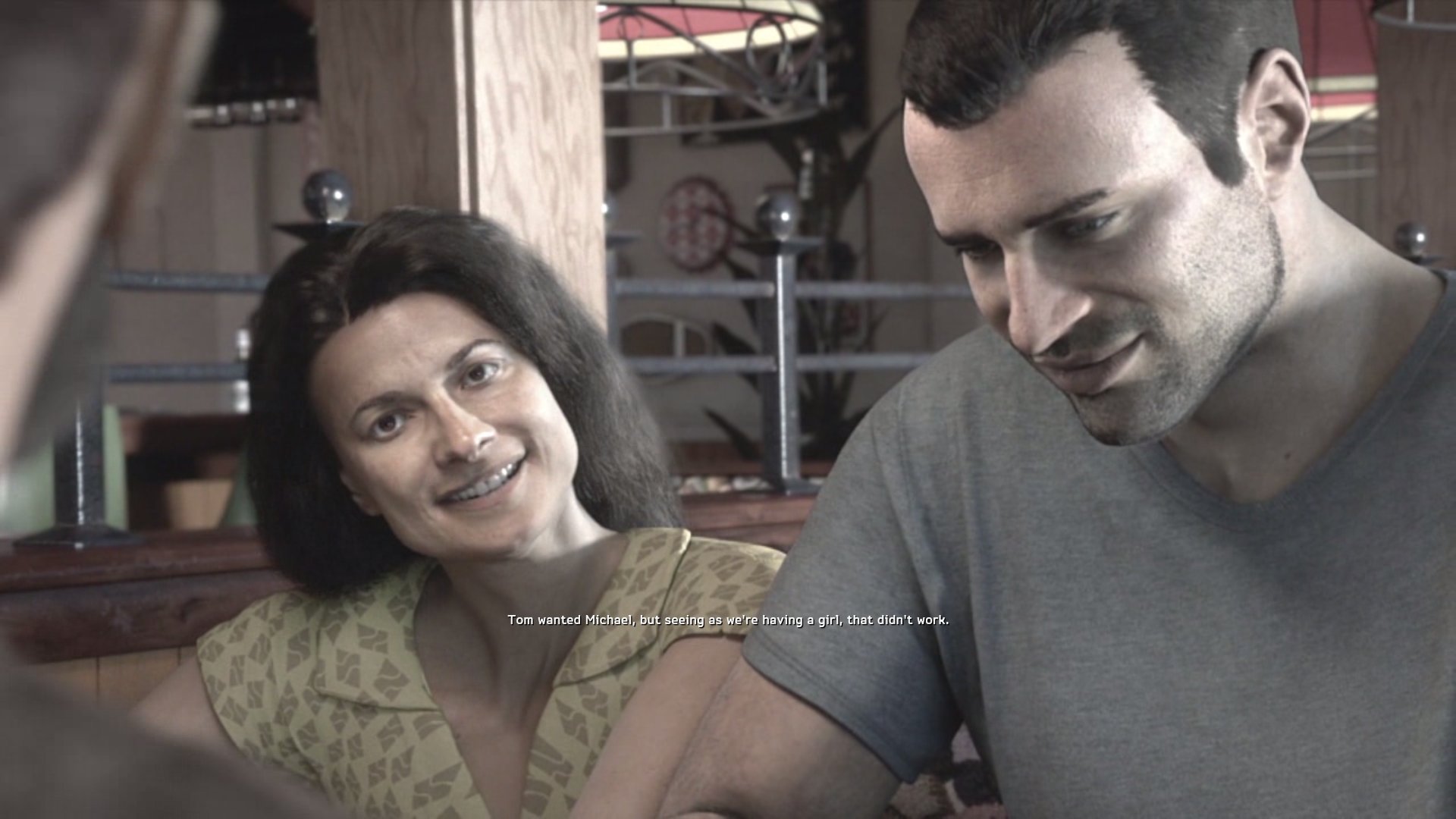
Preacher on the right, a prayer needed for whatever is on the left
You play as Stump and Preacher in the disjointed campaign. Preacher was a main character in MoH 2010, and Stump is an apt name for a soldier with the personality of a tree. Preacher gets most screen time with a story based on the strain war puts on his family. This personal story unfolds through CGI cut scenes that run parallel to the action. Preacher’s wife and daughter, the weirdest looking CGI creatures in recent history, fail to instil the intended emotion. The game does a poor job of making you feel for any of the characters.
It’s hard to keep track of how the missions link together. The bearded battalion of Mother, Dusty and Voodoo return to take you on an adventure loosely related to the explosive substance, PETN. The story is stretched to fit with the locations rather than the other way around. Even the transitions between soldiers’ perspectives are far less effective than before. You would have more luck solving a snow storm themed jigsaw puzzle than you would piecing together this mess. The jumbled story makes it impossible to care about the events.
Warfighter’s campaign is a collection of horrible shooter tropes compressed into five hours. You get enough door breaches to cause mental damage. You command a remote robot that chews through enemies like crate paper. Laser designators target buildings for sterile destruction. Enemies should be thanked for providing waist high cover in the middle of their strongholds. There are car chases too, although these are the game highlight. Perhaps we should be thankful there are no gunship missions. You’ve seen everything done much better elsewhere.
Breaching has never been done quite this badly before. There are around twenty door-kicking, room-entering sequences to endure. Many allow you to choose how to breach. This decision is purely superficial though, removing doors with a tomahawk or explosives changes nothing. The room is flashbanged and you enter to shoot foes in slow motion. One minor surprise to the setup doesn’t reduce the nausea caused by repeated breaching. When a device like breaching is overused, the novelty evaporates and it becomes a liability.

This guy heard there was another breaching sequence, so he set himself on fire
Enemy AI manages to be both horrendous and annoying at the same time. When you are visible, you become their priority regardless of actual threat. They ignore squad members and tend to run straight at you. If you hide, they’ll sheepishly attack friendlies until you show your head again. Perhaps the only compliment the AI could be given is that they throw grenades well enough to get you moving from your fox hole. The bad spawn placements and respawning cause even more damage to the horrific AI.
Friendly AI happens to be less useful than an indoor sundial. They rarely engage opposing forces in a meaningful way, typically shooting inaccurately at impenetrable cover. They prefer to stay behind the action to avoid being seen altogether. When the enemy AI rushes your position, it will be a miracle if your bearded buddies help out. Instead you’ll have time to reload, absorb 10 bullets to the face and shoot them yourself. Towards the end of the campaign, friendly soldiers run through solid objects like they weren’t even there. The friendly AI regularly breaks the authenticity and distracts from the shooting.
The shooting in Warfighter is competent and feels similar to Battlefield 3. The weapons have slick animations but the pacing is more deliberate than in BF3. Guns overuse sights and have high recoil to encourage fire mode switching. It’s a shame you don’t spend the entire campaign with agreeable loadouts. If you are the type of player who likes to change weapons, you’ll get annoyed quickly. Enemy weapons disappear after cut scenes or door breaches. Some even vanish when you switch back to your standard arsenal. It takes some time to acclimatize to the weaponry in Warfighter.
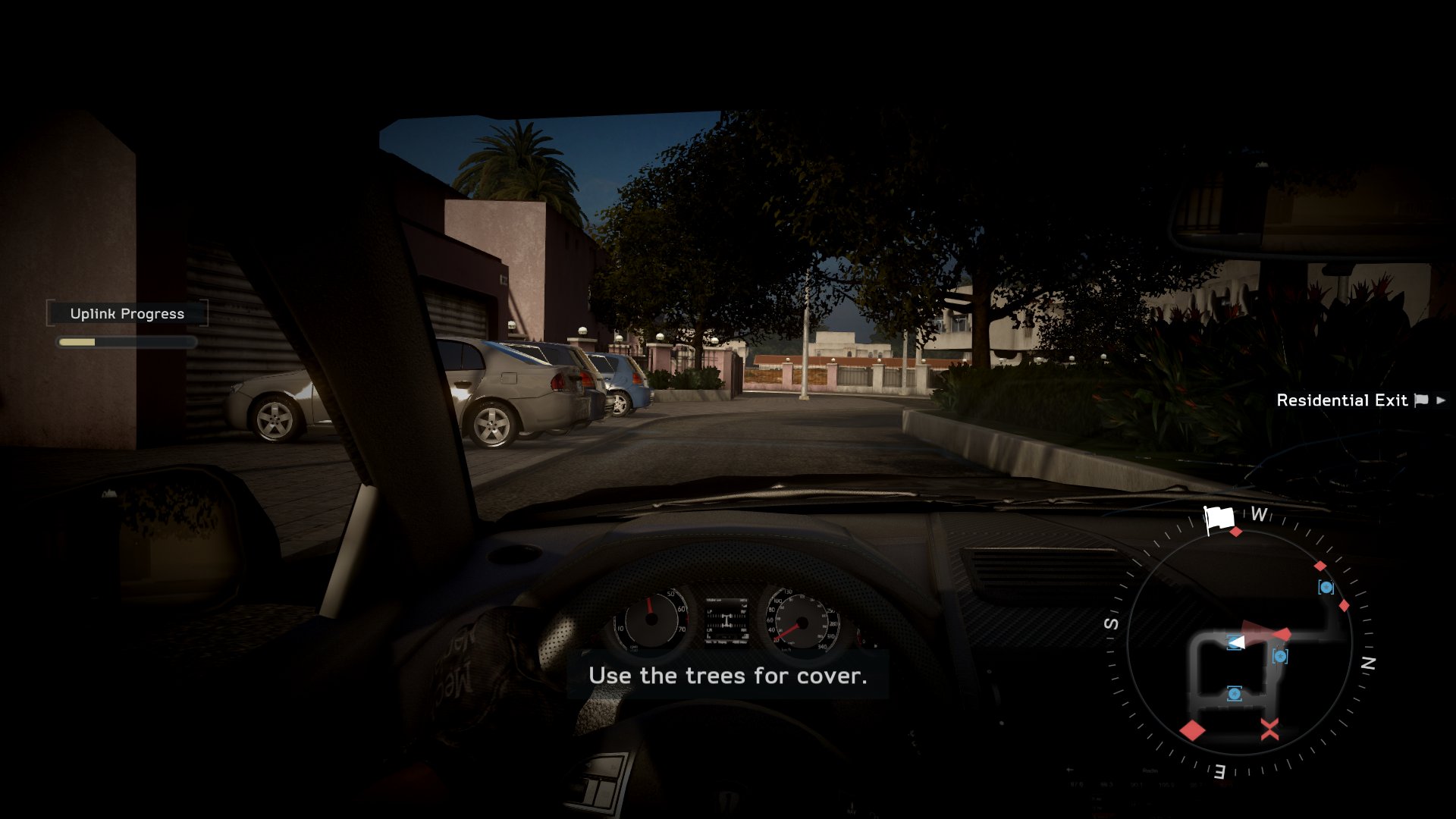
Is this a shooter or Pacman meets Need for Speed?
There are two spots during the campaign where you forgo weapons and get behind the wheel in first person. Both vehicle segments, which use a different version of the Frostbite 2 engine, may jarringly switch display resolutions. These driving missions provide some high octane excitement for short stints. They don’t involve any shooting, just pure driving and ramming into other vehicles. The Pacman like hide and seek component during the second sequence is ineffective. It is rather telling that these driving missions are the best parts in this shooter’s single player.
It’s fortunate that the multiplayer is the superior component in Warfighter. Soldiers from different countries compete alongside each other in familiar multiplayer modes. Different countries, and weapons, are unlocked for each class as you rank up. Playing the game earns you tokens that can be pledged to support your nation. The nation unlock system is an interesting idea that brings some themed customisation to classes. It’s a shame the attachment unlock system is near incomprehensible. The core of the multiplayer is predictable but it remains enjoyable.
The Fireteam setup changes the multiplayer structure slightly. A Fireteam consists of two individuals who can help each other during battle. The pair is able to heal, resupply and even spawn on one another. Staying in cover, so your buddy can spawn, increases your chances of victory. If your friend is killed, do you pursue vengeance to bring him back faster or wait for him to respawn by your side? You’ll want to remain near your Fireteam buddy, even if they aren’t very good. You’ll also see pairs of enemies instead of solo players. The downside is you will feel disadvantaged without a buddy and sad if he leaves mid match. The Fireteam system promotes cohesion and immediate teamwork between pairs.
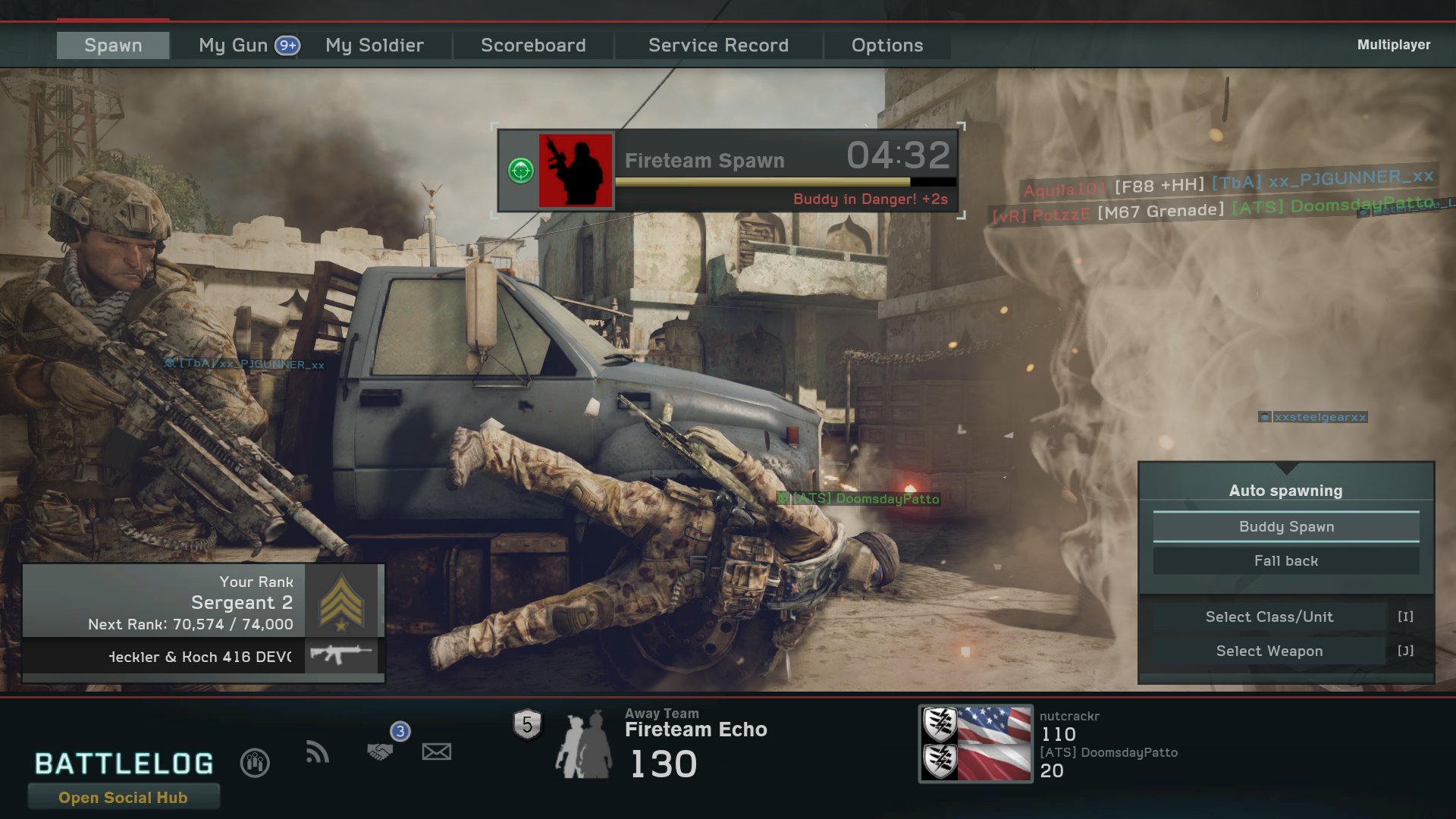
Contrary to this screenshot, flying is not a special ability in multiplayer
Player classes cater for a broad range of player styles. There is the slow moving Demolition class who can equip a helmet to absorb damage at the cost of manoeuvrability. On the other end of the scale, the agile Spec Ops class can briefly see through walls. Each class has a special ability that helps differentiate them from the group. Snipers can deploy a bipod to spot enemies and the Point Man equips a powerful magazine to gain an edge in battle. Most of the weapons and abilities are fairly well balanced. Regardless of your play style, there is a class to suit.
The class support actions don’t dominate the shooting gameplay. They are relatively infrequent but still prove useful. Support actions include; smoke screens, mortars, missiles, remote robots and Apaches. The UAV is launched by throwing a small aeroplane that flies forward and circles around. You will need to be in the right place, facing the intended direction, to use it effectively. Spec Ops can deploy radar jammers that disorientate enemy mini maps. Blackhawk helicopters fly to specific locations and allow your team to quickly return to battle. To reduce effectiveness, normal gunfire destroys Blackhawks and the gunner can be shot out. The support actions expand the idiosyncrasies of each class while maintaining the balance.
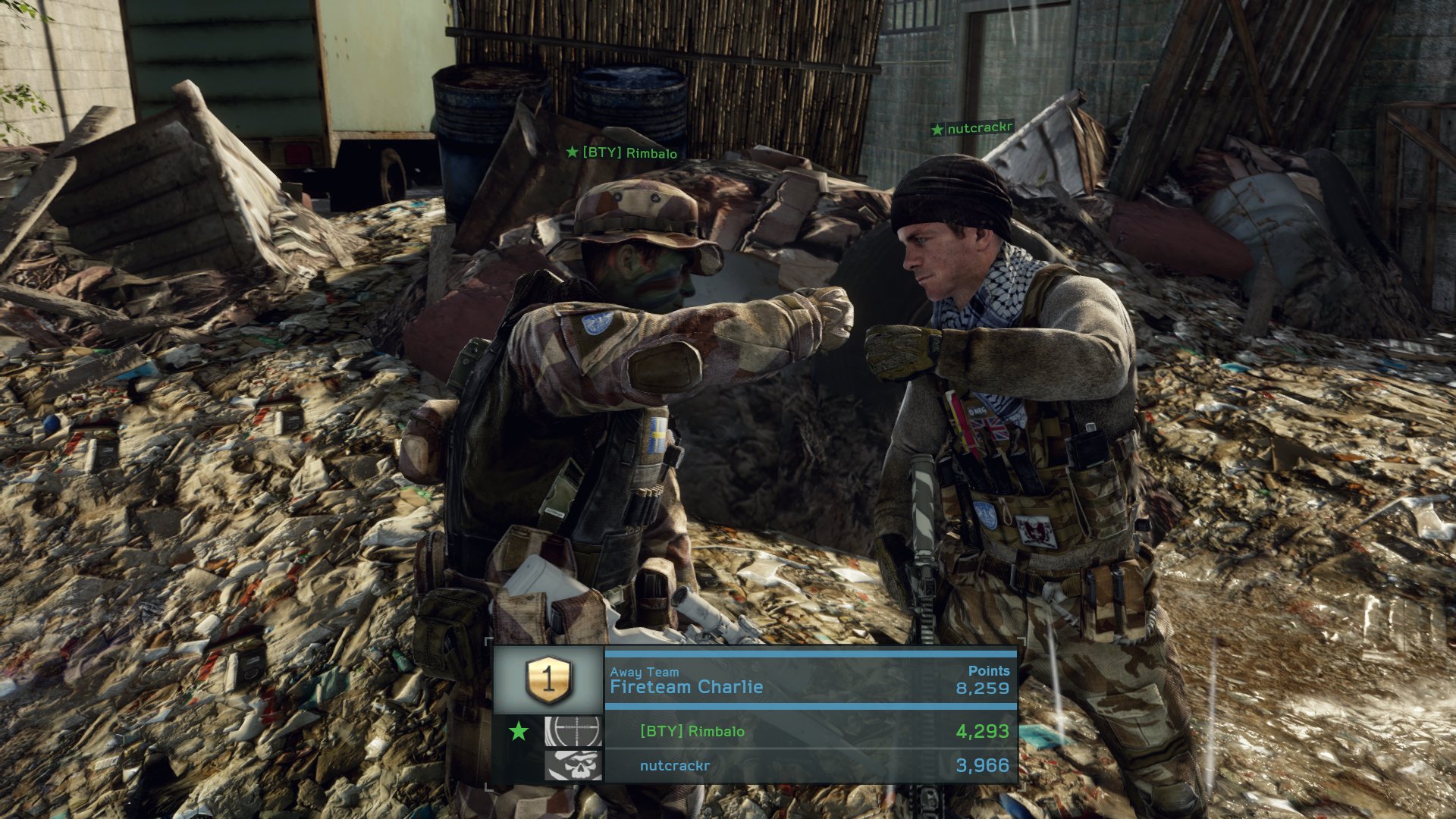
The best Fireteam gets extra tokens and the coveted fist bump animation
The multiplayer maps are well designed for concentrated battles. They omit superfluous detail and are crafted specifically for multiplayer. The Sarajevo stadium map brings the battle around a war torn Luge track. The Basilian Aftermath map is a water logged, post-tsunami map. There is a good variety of layouts and atmospheres in the eight launch maps. Sector Control (Domination) and Team Deathmatch modes are satisfying circular experiences on all maps. Combat mission, just like Rush in BF3, strings together bomb targets that extend the battle arenas. There are multiple locations to plant explosives too, forcing defenders to cover the entire objective area. The map design allows attackers to flank objectives although some do it better than others. With proven modes on good maps, the multiplayer remains engaging.
Warfighter is inconsistent with its use of the incredible Frostbite 2 engine. Some missions look ordinary, with grass materializing before your eyes. Others showcase the strengths; great lighting, wonderful animations and powerful sound. Excellent ambient audio and soldier chatter bring the multiplayer alive. The wonderful destruction effects are mostly absent, only a few wooden crates and fences can be destroyed. The game runs very well, but there are technical problems. Online play can have unexplained lag resulting in players disconnecting or warping. There are also random crashes, server delays and end of round glitches. Overall, Warfighter is a good looking game that performs adequately.
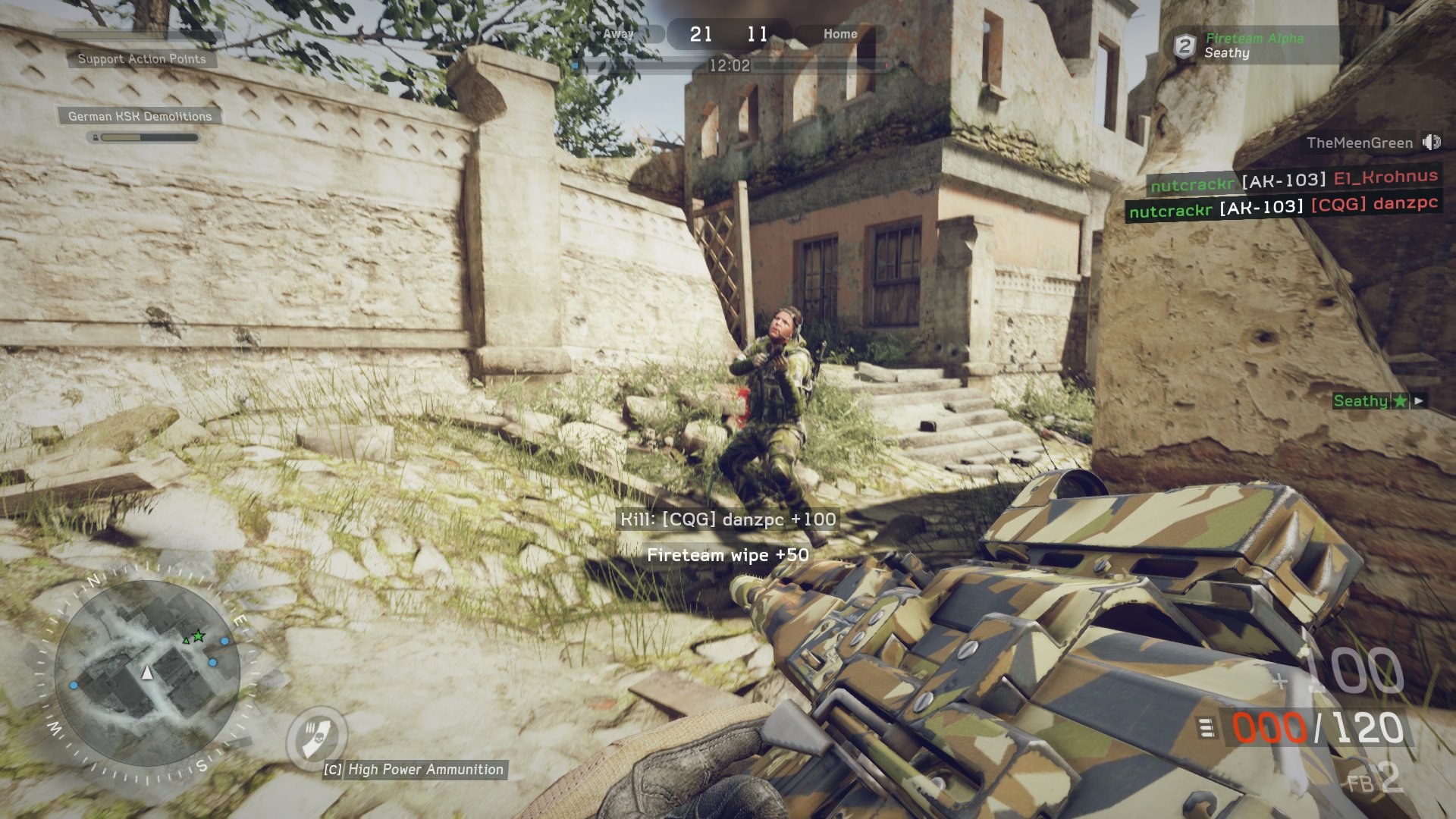
You can paint weapons a dazzling array of colors. That’s what real soldiers do
Medal of Honor: Warfighter reverses the strengths and weaknesses of its predecessor. Single player is probably one of the worst shooters this generation. The disjointed campaign comprises of stupid AI and superficial breaching. The multiplayer is in another league, with enough differences to make it stand out from the saturated genre. The differences aren’t merely cosmetic and can be further appreciated the more you play. Warfighter’s shelf life might not be long, given the already low player count. It will depend on how EA supports it going forward. If you need a modern shooter to scratch that online itch, Warfighter might be a short term solution.
